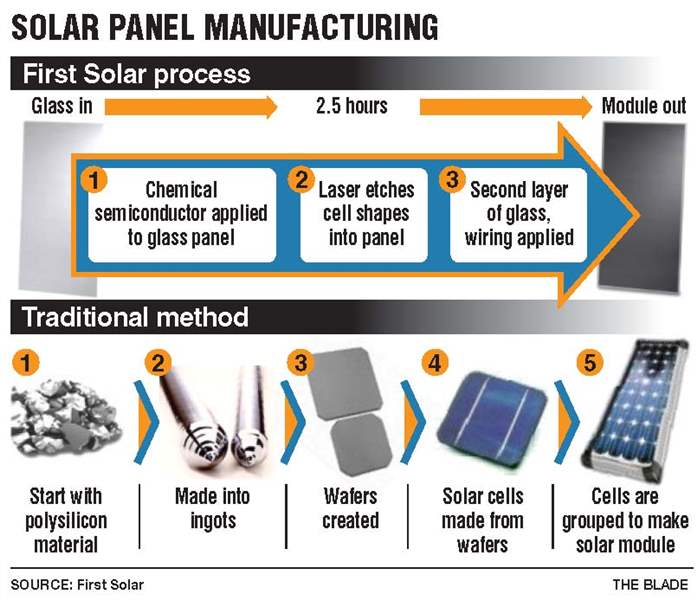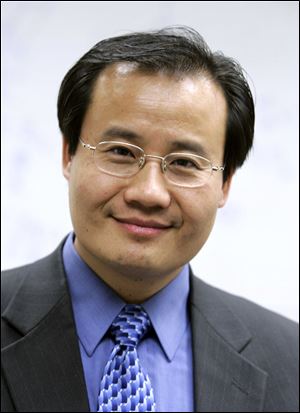
Cost-saving production is choice for First Solar, Xunlight
5/31/2009
SOLAR PANELS churned out at First Solar Inc. in Perrysburg Township have created excitement worldwide because of their low cost and simple design.
Yet seven years after large-scale production started, some experts believe there may be a better way to build this particular mousetrap, modules for converting sunlight into electricity.
The Tempe, Ariz., firm s fast, low-cost production methods continue to encounter intense competition from more established methods and alternative low-cost technologies.
First Solar is among a group of companies using so-called thin-film methods. Some researchers believe that eventually these firms will dominate the industry because their panels, or solar modules, rely on a thin coating of chemicals applied to glass or other surfaces. Because they require less raw material, they are cheaper to produce than traditional panels, which rely on sometimes expensive man-made polysilicon.
The disagreements don t end there. Advocates of thin-film technology differ about which chemical coatings will yield the most efficient panels suitable for mass production.
Even in metro Toledo, which one network news report described as a budding solar valley because of pioneering research and manufacturing in thin-film technologies, experts disagree about the best way to trim manufacturing costs while helping reduce the world s addiction to pollution-producing fossil fuels.
Besides First Solar, three other Toledo-linked firms are seeking to commercialize the lower-cost manufacturing methods. Two use thin-film processes similar to First Solar s.
The third, Xunlight Corp., is banking on a different thin-film process that replaces the glass used by the others with a thin layer of stainless steel and a different combination of chemical compounds.

Xunlight, now in pilot production of solar panels that can be rolled up for shipping, doesn t expect to begin making products for sale until late 2009 or early next year. I expect our cost to be similar to First Solar when we get to similar capacity, said Chief Executive Xunming Deng.
He refrained from criticizing First Solar or its approach to manufacturing. First Solar is a very well-run company, Mr. Deng said in a telephone interview from Munich, where he was promoting Xunlight panels at a trade fair. They have been serving as a role model in the industry.
The issue of who has the best technology takes on increased importance now, because many panel producers are struggling in a supply glut and international credit crisis that has prompted customers to cancel orders and delay construction of solar farms.
Globally, there s been a kind of softening of demand, said Monique Hanis, spokesman for the Solar Energy Industries Association in Washington. In addition to other developments, some European nations have studied reductions in subsidies for solar power.

Deng
First Solar, the world s largest producer of panels using thin-film technology, is among a small number of suppliers that continue to thrive. It posted profits of $165 million on sales of $418 million in the first quarter. That was up from $47 million in profit on sales of $197 million at the same time in 2008.
Its only North American panel-making plant is in suburban Toledo, and the firm began in Toledo. A $100 million expansion program is under way at the firm s research center and factory in Perrysburg Township.
When the expansion is completed, First Solar will have two dozen production lines in the United States, Germany, and Malaysia. In Perrysburg Township, annual production will rise to 2.8 million 2-foot-by-4-foot panels from 2 million now.
Still, when President Obama spoke last week about clean energy in front of a solar array at Nellis Air Force base near Las Vegas, the panels weren t from First Solar. The solar farm, the largest in North America, has 70,000 panels produced in 2007 by a group of manufacturers led by California-based SunPower Corp., using traditional manufacturing methods.
For years, solar panels were made in a time-consuming process. They begin with six-inch cell-shaped wafers made of polysilicon, the same material used in computer chips; it inspired the name Silicon Valley for California s chip-technology hub.
In the process, polysilicon is first produced in chunks, then is formed into ingots and eventually into wafers. Individual wafers are transformed into solar cells that are assembled into panels.
Researchers long sought faster, less costly ways to make panels.
Rather than create small individual cells, manufacturers using thin-film processes apply a thin chemical coating known as a semiconductor to a solid surface such as a sheet of glass or stainless steel. Laser scribes then etch cells into the panel.
The biggest advantage, advocates noted, is that this process takes much less time 2 hours for a 2-foot by 4-foot panel at First Solar and uses far less chemical compound. At First Solar, each panel contains just 1 percent of the amount of chemical compound used in traditional solar panels, officials say.
This has been especially significant in recent years when the price of polysilicon, the main raw material of traditional panels, at times rose as high as $500 a kilogram, about 2.2 pounds.
Prices have moderated in recent months as supplies have increased.
Traditional panels are not without advantages. For one, they convert a range of 17 to 19 percent of sunlight into electricity, compared with 11 percent at First Solar.
But, unlike traditional panels, thin-film panels aren t reliant on just one main raw material to produce semiconductors.
First Solar uses cadmium telluride. Its main ingredient is cadmium, a by-product of zinc mining.
Xunlight, which employs technology licensed from the University of Toledo, uses man-made amorphous silicon, a sometimes-pricey form of polysilicon. But panels made at its pilot plant on Nebraska Avenue in Toledo use only a tiny fraction of the amount of the material that would be used in traditional manufacturing.
Some researchers believe that chemical compounds other than cadmium telluride eventually will prove to be superior for thin-film panels. Critics note that cadmium can cause cancer, although officials of First Solar, along with other firms using the technology, insist that production methods guard against that.
Stock analysts at Deutsche Bank Securities Inc. predict that panels made with cadmium will account for 13 percent of global production this year, up from 10 percent last year. They attribute most of that to growth at First Solar.
Traditional panels continue to dominate and are expected to make up 76 percent of panels, down from 87 percent just two years ago, Deutsche Bank said.
Other Toledo-linked firms seeking to commercialize thin-film panels using cadmium telluride include Calyxo USA Inc., a subsidiary of German panel giant Q-Cells AG, which has a research operation it acquired in Perrysburg.
Willard & Kelsey Solar Group LLC, launched by Toledo entrepreneurs, has said it will begin commercial production using similar technology this year in a converted television components factory in Perrysburg. It is studying offers from Perrysburg, Orlando, Fla., and several other cities seeking its corporate headquarters and a larger plant.
Officials of those firms did not return calls seeking comment.
Manufacturers goal is to cut costs to a level where panels can be sold cheaply enough to make solar energy competitive with electricity from coal-fired plants and other traditional sources.
To cut prices to that point, production costs must drop to about 65 cents per watt of power each panel is capable of producing, First Solar officials estimate. The firm broke $1 a watt Dec. 31 and fell to 93 cents March 31, executives said in securities filings. Costs continue to drop at about 10 percent a year. Xunlight is too new to have such data.
Declining costs for raw materials and advances in technology are helping manufacturers of traditional panels to cut production costs as well. Analysts at Deutsche Bank Securities foresee a drop to $1.70 a watt by next year. Given that panels produced by First Solar are slightly less efficient than traditional panels, it is important that the firm is able to sell at lower prices, executives acknowledge.
To deal with the challenge, First Solar doubled research spending to more than $30 million last year.
Steve O Rourke, an analyst at Deutsche Bank Securities in New York, said he expects the current supply glut to lead to an industry shake-out that will benefit two firms: First Solar and SunPower Corp.
First Solar and SunPower are clear industry leaders and have sustainable competitive advantages, he said. First Solar, he wrote in a report, offers the most compelling value proposition in the industry. And he predicted that the firm, along with SunPower, which sells highly efficient panels made with traditional methods, will do the most to define and advance the solar panel industry in future years.
Contact Gary Pakulski at:gpakulski@theblade.comor 419-724-6082.